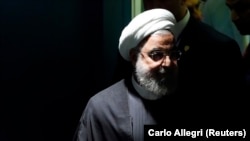Iranian President Hassan Rouhani made three claims about the state of Iran's economy in his speech at the UN General Assembly on September 25 - all highly questionable.
He announced to the world that the Islamic Republic of Iran's economy has had the highest growth rate in the world in 2017 and amazingly it was accompanied by a decreasing inflation rate.
Meanwhile, he claimed that the economy has returned to a trend marked by stability and growth since 18 months ago, that is Spring 2018.
The question is: Was he speaking the truth about Iran's economy?
One must remember the background of Iran's economy and its recent ups and downs in order to verify Rouhani's claims.
Tensions created by former President Mahmoud Ahmadinejad about Iran's nuclear program after his election in 2005 finally led to a series of sanctions imposed by the United Nations Security Council in 2012. As a result, Iran's economic growth rate declined by 8.5 percent.
The average economic growth rate in the Islamic Republic of Iran was less than one percent (0.80%) between the years 2010 and 2015.
After 2013, when Hassan Rouhani was elected President, the country's economic growth was negative for two years. In 2015, Iran's economy became 1.6 percent smaller.
Since January 2016 when some of the international sanctions were lifted as a result of the nuclear deal with the West, Iran's oil-based economy experienced some growth. Based on the most optimistic assessments, the country's economic growth rate reached to more than 10 percent.
This growth was the outcome of resumption of exporting oil after several years of reduction and stagnation caused by backbreaking sanctions. In other words, oil production in that year had a growth only in comparison to the stagnation period which was nothing comparable to normal years.
Here, like in many other areas, the Islamic Republic simply compares "bad" with "worse" and declares its bad policies to be a victory and expects the nation to be grateful for it.
At the same period, Iran's economy was in crisis. One of the signs of this crisis was that the rate of growth in Iran's industry was less than one percent in the first half of the same year (2016). This was the year before 2017 when Hassan Rouhani claims Iran had the highest rate of economic growth in the world.
It is true that the Rouhani administration managed to increase the country's oil output from its reduced level of one million barrels per day to 3.8 million barrels. But this was still far less than the 6 million barrels Iran produced before the 1979 Islamic revolution.
Nevertheless, and regardless of that increase in oil output, according to the World Bank's estimate, Iran's economic growth rate in 2017 was around 3.7 percent. And that was not the highest rate in the world. In the same year India and China had growth rates over 6 percent.
As regards Rouhani's second claim about the inflation rate, Iranian official statistics for 2017 show an inflation rate above 60 percent and an increased unemployment rate as high as 12 percent.
But a reduction in inflation rate does not mean a reduction in inflation. Let us assume someone falls off a 1000-meter cliff with a speed of 500 kilometres per hour. Now, let us assume that headwinds and other factors reduce the speed of the man's fall to 150 kilometres per hour. Can this reduction in speed save the man from the deadly consequences of his fall?
And as regards Rouhani's third claim, is it really true that Iran's economy has been en route to stability and growth in the past 18 months?
Based on international statistics, Iran's economic growth has been negative in the past two years. It was minus 3.8% in 2018 and it further shrank by 6.3 percent in 2019. Nevertheless, the Islamic Republic claims that based on an International Monetary Fund (IMF) estimate the decline in Iran's Gross National Product (GNP) has ended and that it will grow after 2020.
This is a misleading fallacy because Rouhani is only pointing out the growth, but refuses to say how much Iran's growth rate has been according to the IMF. The IMF has estimated Iran's total growth during the five years from 2020 to 2025 to rise to around only 4 percent.
This means that the Islamic Republic's economic growth in the next five years can never compensate the 11% fall during 2018 and 2019.








